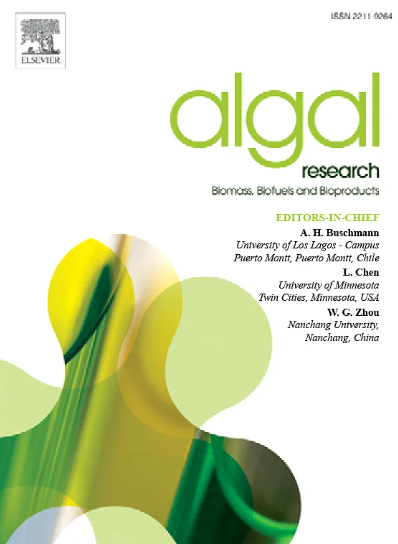解读二癸基甲基丙基碘化铵根除铜绿微囊藻的分子机制:转录组学和生理学的结合方法
IF 4.6
2区 生物学
Q1 BIOTECHNOLOGY & APPLIED MICROBIOLOGY
Algal Research-Biomass Biofuels and Bioproducts
Pub Date : 2025-05-26
DOI:10.1016/j.algal.2025.104116
引用次数: 0
摘要
全球对蓝藻繁殖的有害影响的关注正在上升。化学防治在控制蓝藻华中具有广阔的应用前景。二癸基甲基丙基碘化铵(DMPAI)已被证明是一种有效且相对安全的控制微囊藻华的试剂,其效果已在中试现场得到验证。本研究通过田间杀藻实验,通过转录组学和生理实验,探讨了DMPAI对铜绿微囊藻的杀藻机理。田间试验表明,DMPAI对铜绿假单胞菌具有显著的杀藻效果。显微镜分析表明,DMPAI处理引起蓝藻细胞表面凹陷和细胞裂解。OJIP瞬态测量结果显示,0.5 mg/L DMPAI使荧光诱导曲线的j -步(~2 ms)和i -步(~30 ms)显著升高。生化分析表明,DMPAI处理先提高抗氧化酶活性和MDA水平,然后降低。转录组学分析显示,DMPAI处理下,共有158个基因发生了显著变化。主要研究结果显示谷胱甘肽过氧化物酶明显下调,分子伴侣减少,atp酶增加,光系统II蛋白显著变化。综合结果表明,DMPAI通过破坏抗氧化系统、破坏膜脂蛋白、影响能量合成、阻碍光合能力等途径抑制铜绿假单胞菌,显示出较强的杀藻效果。这些发现突出了DMPAI的强效杀藻特性及其在控制蓝藻华方面的潜在应用,这可能有助于未来的环境管理策略。本文章由计算机程序翻译,如有差异,请以英文原文为准。
Deciphering the molecular mechanisms of Microcystis aeruginosa eradication by didecyl methyl propyl ammonium iodide: A combined transcriptomic and physiological approach
Global concern is rising over the harmful impact of cyanobacterial blooms. Chemical prevention has broad prospects in controlling cyanobacterial blooms. Didecyl methyl propyl ammonium iodide (DMPAI) has been proven to be an effective and relatively safe reagent for controlling Microcystis blooms, with its efficacy in pilot test field applications already verified. In our research, field - scale killing experiments were carried out, and by means of transcriptomic and physiological experiments, we investigated the algicidal mechanism of DMPAI against Microcystis aeruginosa. The field experiments demonstrated that DMPAI exhibits a remarkable algicidal effect on M. aeruginosa. Microscopic analysis disclosed that DMPAI treatment caused surface depressions and cell lysis in cyanobacterial cells. OJIP transient measurements revealed that DMPAI at 0.5 mg/L caused marked elevation of the J-step (at ~2 ms) and I-step (at ~30 ms) in the fluorescence induction curve. Biochemical analysis showed that DMPAI treatment initially increased antioxidant enzyme activities and MDA levels, followed by a decrease. The transcriptomic analysis revealed that under DMPAI treatment, a total of 158 genes exhibited significant changes. Key findings show a marked downregulation of glutathione peroxidase, decreased molecular chaperones, increased ATPases, and notable changes in photosystem II proteins. The comprehensive results suggests that DMPAI inhibits M. aeruginosa by impairing the antioxidant system, damaging membrane lipid proteins, impacting energy synthesis, and hindering photosynthetic capacity, thus showing strong algicidal effectiveness. These findings highlight DMPAI's potent algicidal properties and its potential application in controlling cyanobacterial blooms, which may contribute to future environmental management strategies.
求助全文
通过发布文献求助,成功后即可免费获取论文全文。
去求助
来源期刊

Algal Research-Biomass Biofuels and Bioproducts
BIOTECHNOLOGY & APPLIED MICROBIOLOGY-
CiteScore
9.40
自引率
7.80%
发文量
332
期刊介绍:
Algal Research is an international phycology journal covering all areas of emerging technologies in algae biology, biomass production, cultivation, harvesting, extraction, bioproducts, biorefinery, engineering, and econometrics. Algae is defined to include cyanobacteria, microalgae, and protists and symbionts of interest in biotechnology. The journal publishes original research and reviews for the following scope: algal biology, including but not exclusive to: phylogeny, biodiversity, molecular traits, metabolic regulation, and genetic engineering, algal cultivation, e.g. phototrophic systems, heterotrophic systems, and mixotrophic systems, algal harvesting and extraction systems, biotechnology to convert algal biomass and components into biofuels and bioproducts, e.g., nutraceuticals, pharmaceuticals, animal feed, plastics, etc. algal products and their economic assessment
 求助内容:
求助内容: 应助结果提醒方式:
应助结果提醒方式:


